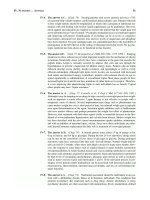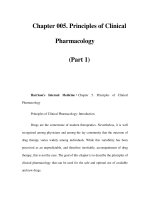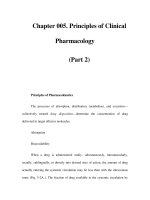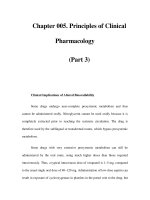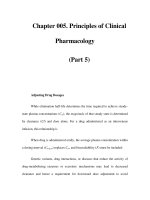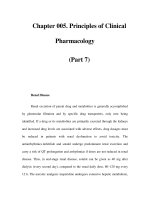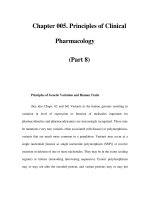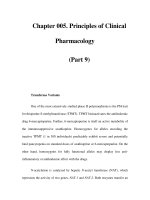Chapter 005. Principles of Clinical Pharmacology (Part 2) ppt
Bạn đang xem bản rút gọn của tài liệu. Xem và tải ngay bản đầy đủ của tài liệu tại đây (24.05 KB, 8 trang )
Chapter 005. Principles of Clinical
Pharmacology
(Part 2)
Principles of Pharmacokinetics
The processes of absorption, distribution, metabolism, and excretion—
collectively termed drug disposition—determine the concentration of drug
delivered to target effector molecules.
Absorption
Bioavailability
When a drug is administered orally, subcutaneously, intramuscularly,
rectally, sublingually, or directly into desired sites of action, the amount of drug
actually entering the systemic circulation may be less than with the intravenous
route (Fig. 5-2A ). The fraction of drug available to the systemic circulation by
other routes is termed bioavailability. Bioavailability may be <100% for two
reasons: (1) absorption is reduced, or (2) the drug undergoes metabolism or
elimination prior to entering the systemic circulation.
When a drug is administered by a nonintravenous route, the peak
concentration occurs later and is lower than after the same dose given by rapid
intravenous injection, reflecting absorption from the site of administration (Fig. 5-
2). The extent of absorption may be reduced because a drug is incompletely
released from its dosage form, undergoes destruction at its site of administration,
or has physicochemical properties such as insolubility that prevent complete
absorption from its site of administration. Slow absorption is deliberately designed
into "slow-release" or "sustained-release" drug formulations in order to minimize
variation in plasma concentrations during the interval between doses.
"First-Pass" Effect
When a drug is administered orally, it must transverse the intestinal
epithelium, the portal venous system, and the liver prior to entering the systemic
circulation (Fig. 5-3). Once a drug enters the enterocyte, it may undergo
metabolism, be transported into the portal vein, or undergo excretion back into the
intestinal lumen. Both excretion into the intestinal lumen and metabolism decrease
systemic bioavailability. Once a drug passes this enterocyte barrier, it may also be
taken up into the hepatocyte, where bioavailability can be further limited by
metabolism or excretion into the bile. This elimination in intestine and liver, which
reduces the amount of drug delivered to the systemic circulation, is termed
presystemic elimination, or first-pass elimination.
Drug movement across the membrane of any cell, including enterocytes
and hepatocytes, is a combination of passive diffusion and active transport,
mediated by specific drug uptake and efflux molecules. The drug transport
molecule that has been most widely studied is P-glycoprotein, the product of the
normal expression of the MDR1 gene. P-glycoprotein is expressed on the apical
aspect of the enterocyte and on the canalicular aspect of the hepatocyte (Fig. 5-3);
in both locations, it serves as an efflux pump, thus limiting availability of drug to
the systemic circulation. P-glycoprotein is also an important component of the
blood-brain barrier, discussed further below.
Drug metabolism generates compounds that are usually more polar and
hence more readily excreted than parent drug. Metabolism takes place
predominantly in the liver but can occur at other sites such as kidney, intestinal
epithelium, lung, and plasma. "Phase I" metabolism involves chemical
modification, most often oxidation accomplished by members of the cytochrome
P450 (CYP) monooxygenase superfamily. CYPs that are especially important for
drug metabolism (Table 5-1) include CYP3A4, CYP3A5, CYP2D6, CYP2C9,
CYP2C19, CYP1A2, and CYP2E1, and each drug may be a substrate for one or
more of these enzymes. "Phase II" metabolism involves conjugation of specific
endogenous compounds to drugs or their metabolites. The enzymes that
accomplish phase II reactions include glucuronyl-, acetyl-, sulfo- and
methyltransferases. Drug metabolites may exert important pharmacologic activity,
as discussed further below.
Table 5-1 Molecular Pathways Mediating Drug Disposition
Molecule Substrates
a
Inhibitors
a
CYP3A
Calcium channel
blockers
Amiodarone
Antiarrhythmics
(lidocaine, quinidine,
mexiletine)
Ketoconazole,
itraconazole
HMG-CoA
reductase inhibitors
("statins"; see text)
Erythromycin,
clarithromycin
Cyclosporine, Ritonavir
tacrolimus
Indinavir,
saquinavir, ritonavir
CYP2D6
b
Timolol,
metoprolol, carvedilol
Quinidine (even
at ultra-low doses)
Phenformin Tricyclic
antidepressants
Codeine Fluoxetine,
paroxetine
Propafenone,
flecainide
Tricyclic
antidepressants
Fluoxetine,
paroxetine
CYP2C9
b
Warfarin Amiodarone
Phenytoin Fluconazole
Glipizide Phenytoin
Losartan
CYP2C19
b
Omeprazole
Mephenytoin
Thiopurine S-
methyltransferase
b
6-Mercaptopurine,
azathioprine
N-acetyltransferase
b
Isoniazid
Procainamide
Hydralazine
Some sulfonamides
UGT1A1
b
Irinotecan
Pseudocholinesterase
b
Succinylcholine
P-glycoprotein Digoxin Quinidine
HIV protease
inhibitors
Amiodarone
Many CYP3A
substrates
Verapamil
Cyclosporine
Itraconazole
Erythromycin
a
Inhibitors affect the molecular pathway, and thus may affect substrate.
b
Clinically important genetics variants described.
A listing of CYP substrates, inhibitors, and inducers is maintained at
